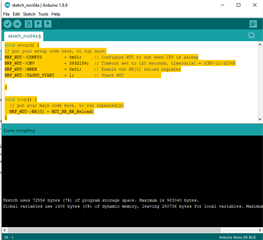Writing an app for the Arduino Nano 33 BLE Sense:
https://store.arduino.cc/usa/nano-33-ble-sense
Basically I am reading all sensors on the Sense board (temperature, humidity, pressure, acceleration, gyro, light, noise), sending the data to a Raspberry Pi for processing, and then to Graphite for long term storage, and visualization with Grafana. This is the project page:
https://github.com/FlorinAndrei/WeatherStation
So far so good and the project works pretty well. But there's one snag:
Every few days the Arduino sketch stops working - it just hangs. I will attempt to troubleshoot it and figure out what causes the hang - there are several libraries I'm using for the various sensors, and perhaps there's a bad interaction somewhere. Or some memory leak, I'm not sure.
Anyway, meanwhile, if I had a way to trigger a watchdog to reset the board, that would be an acceptable workaround.
Is there a library I could integrate with the Arduino IDE that would give me a watchdog for this CPU? And is that documented somewhere, with examples?
Thanks!



